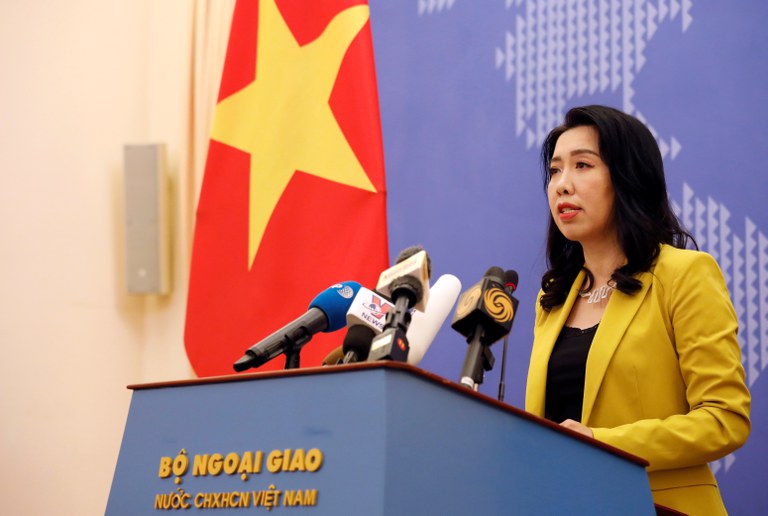Vietnam ‘opinion workers’ push Russian fake news on Ukraine on social media
Vietnamese “opinion workers” who promote the Communist Party and protect its image on social media now have a new role: spreading fake or misleading reports that support Russia’s invasion of Ukraine on Facebook. Facebook groups like “Đơn vị Tác chiến Mạng” (Cyber CombatUnit), “Truy quét Phản động” (Elimination of Reactionary Forces), “Bộ Tự lệnh Tác chiến” (Combat Command), and “Trung đoàn 47” (Regiment 47) that have worked to counter criticism of the Communist Party all now post information in favor of Russia. For example, Trung đoàn 47, which is believed to be part of a cyber combat force in the Vietnam People’s Army, posted this justification for the invasion: “Mr. Putin said: ‘Moscow has done everything it can to maintain Ukraine’s territorial integrity as well as protect the interests of Donetsk and Lugansk’s people but Kiev had blocked Donbas, suppressing local residents and shelling Donbas.’” Đơn vị Tác chiến Mạng posts fake news on a nearly daily basis. One video clip shows Ukrainian President Volodymyr Zelenskyy meeting with members of his Cabinet and a close-up shot of a handful of white powder on his desk that looks like heroin. Đơn vị Tác chiến Mạng claimed that Zelensky posted this video on his website before it was quickly deleted. Facebook attached an alert on the video to let viewers know it is an altered recording, though it is still available. Even wider of the mark has been coverage of the massacre in Bucha, a town outside the capital Kyiv where hundreds of Ukrainians were killed by Russian soldiers. The torture and murder of Bucha residents apparently carried out by Russian soldiers before Ukrainian forces retook the town has drawn international calls to bring perpetrators to justice for war crimes. But Don Vi Tac Chien Mang said the atrocities were faked by Ukraine officials and soldiers, who, the Facebook group claimed, transported the corpses to Bucha from another location. RFA sent evidence to prove the video was fake to Meta, Facebook’s parent company, asking for comment as to why the social media platform had not yet identified it as such. A team representative said a response would be forthcoming within 24 hours, but RFA did not receive a reply. ‘It cannot discourage me’ The pro-Russian disinformation comes from a force of tens of thousands of cyber troops created by the Hanoi regime to watch and attack people online for posting information seen as detrimental to the Vietnamese Communist Party. Targets include individual netizens like Phan Chau Thanh, a Vietnamese businessman living in Poland who along with his friends began to organize the delivery of relief aid to Ukraine refugees in Poland right after the war broke out. “I find this war extremely unjustifiable,” Thanh said. “How can Russia carry out an invasion of another country right in the middle of Europe in the 21st century? Therefore, I want to provide Vietnamese people with updates about the war through the eyes of a person living in Europe.” Posts from his Facebook account garner thousands of views among Vietnamese, including government officials and the army of official influencers. “Since the war started, or over the past 60 days, my Facebook account has been blocked four times,” he said, due to reports accusing him of violating Facebook’s community standards. In December 2021, Meta, Facebook’s parent, announced that it had removed from the site a network of users who attacked political dissidents in Vietnam through similar methods. Thanh said he has also received a flurry of obscene and nasty comments, a typical tactic of Vietnamese cyber troops. “Of course, it makes me feel down, but it cannot discourage me,” he said. “It irritates me, but in many cases it gives me stronger determination to keep going.” RFA sent Facebook a message containing Phan Chau Thanh’s complaints but did not receive a response. In many cases, Vietnamese opinion workers are amplifying fake news created by Russian propagandists. Their influence could be seen recently when a video of four Ukrainian men ripping apart Vietnamese flags went viral on Facebook, passed on as “evidence” of the Ukrainian government’s hostile view toward the Southeast Asian nation. The video fueled a wave of criticism against Ukraine and served to support the Vietnamese government’s decision to maintain neutrality in the face of Russia’s brutal attack. It turned out the flag-tearing incident occurred in the Ukrainian city of Kharkiv 16 years ago. Fallout from the video Oleksandr Gaman, Ukraine’s ambassador to Vietnam, was forced to address the fallout from the video on the embassy’s Facebook page. “The information war, part of the burning war in Ukraine, has come to Vietnam. Russia is making every effort to create frictions between Ukrainian and Vietnamese people,” Gaman said in a video speech posted on April 19, adding that old videos and photos and fake facts were being presented as the official position of Ukraine. A representative from the Ukrainian Embassy in Hanoi told RFA that Russia also has a large army of fake newsmakers. Natalia Zhynkina, the embassy’s temporary chargé d’affaires, said Russia was taking advantage of the image of the former Soviet Union, a country that supported Vietnam during its war with the United States, to make its propaganda appealing to the Vietnamese. But she questioned the effectiveness of Russia’s tactics. “A question should be asked about the effectiveness of Russia’s communication attempts in Vietnam,” she told RFA. “I believe that the information created by Russia has failed to attract the attention of young people. A communication campaign based on hostility and a war will never succeed.” Despite Russia’s efforts, many Vietnamese have shown support for Ukraine in various ways. Hundreds of people in Hanoi have taken part in events at the Ukrainian Embassy and fundraising events to raise money for those affected by the armed conflict. Reported by RFA’s Vietnamese Service. Translated by Anna Vu. Written in English by Roseanne Gerin.




